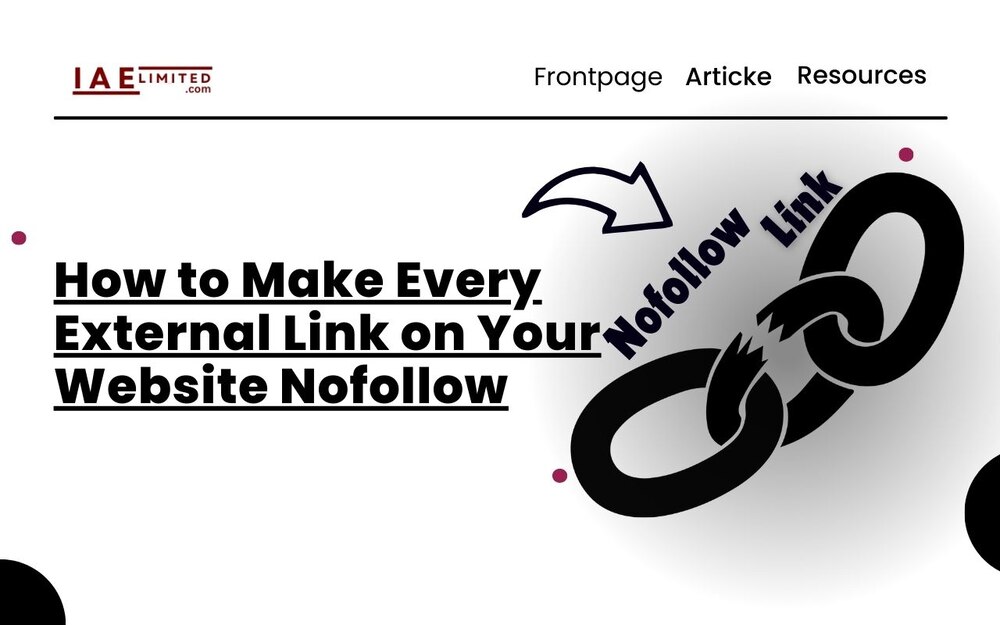
Introduction
Table of Contents
Marking external links as nofollow is a crucial strategy for managing link equity and influencing how search engines treat your site’s links. By making every external link nofollow, you prevent search engines from passing on link juice to other websites, which helps you control the flow of SEO value.
This guide will explore various methods to apply the nofollow attribute to external links, including HTML, JavaScript, and CMS plugins, ensuring you can implement this SEO practice effectively.
Why Use the Nofollow Attribute?
1 Managing Link Equity
The nofollow attribute helps manage the distribution of link equity, ensuring that your site’s SEO value is not diluted by passing it to external sites. This practice can be beneficial for controlling which links contribute to your site’s ranking and preventing potential spam.
2 Preventing Spam
Adding nofollow to external links reduces the risk of your site being associated with low-quality or spammy websites. This practice helps maintain the integrity of your site’s SEO and prevents it from being negatively impacted by untrusted links.
3 SEO Strategy
Using nofollow links strategically can help focus your site’s SEO efforts on internal linking and high-quality backlinks. This can contribute to a more effective overall SEO strategy.
Method 1: Using HTML
1 Adding rel="nofollow" Manually
To make an external link nofollow, you need to add the rel="nofollow" attribute to each <a> tag. Here’s an example:
<a href="https://example.com" rel="nofollow">Visit Example</a>Benefits of Manual Implementation
- Precision: Allows you to target specific links individually.
- Control: Provides full control over which links are marked as nofollow.
2 Considerations
- Manual Effort: This method requires manually updating each link, which can be time-consuming for large sites.
- Maintenance: Every new external link needs to be updated with the nofollow attribute.
Method 2: Using JavaScript
1 Automatically Adding rel="nofollow"
For a more automated approach, you can use JavaScript to add the nofollow attribute to all external links on your site. Here’s a script you can add to your site’s header or footer:
<script>
document.addEventListener("DOMContentLoaded", function() {
var links = document.querySelectorAll('a');
links.forEach(function(link) {
if (link.hostname !== window.location.hostname) {
link.setAttribute('rel', 'nofollow');
}
});
});
</script>2 Benefits of Using JavaScript
- Efficiency: Automatically applies the nofollow attribute to all external links without manual intervention.
- Consistency: Ensures uniform application of the nofollow attribute across the site.
3 Considerations
- Performance: Ensure the script does not affect site load times.
- Compatibility: Test the script across different browsers to ensure proper functionality.
Method 3: Using CMS Plugins
1 For WordPress Users
If you use WordPress, several plugins can automate the process of adding nofollow to external links. Some popular options include:
How to Install a Plugin
- Navigate to Plugins: Go to the WordPress admin panel, click on “Plugins,” and select “Add New.”
- Search and Install: Search for the desired plugin, install, and activate it.
- Configure Settings: Follow the plugin’s settings to apply nofollow to external links.
2 For Other CMS Platforms
For other CMS platforms, look for similar plugins or modules that can handle external link attributes. Many platforms offer extensions for managing link behavior.
Method 4: Using Google Tag Manager
1 Implementing via Google Tag Manager
Google Tag Manager allows you to run custom JavaScript without altering your site’s core code. Here’s how to use it to add nofollow to external links:
- Create a New Tag: In Google Tag Manager, create a new tag and select “Custom HTML.”
- Insert the Script: Add the JavaScript code to apply nofollow.
- Set Triggers: Configure the tag to fire on all pages.
- Publish Changes: Save and publish your changes.
2 Advantages
- Centralized Management: Manage link attributes through Google Tag Manager, which is convenient for sites with frequent updates.
- Non-Intrusive: Apply changes without directly modifying your site’s source code.
Comparison Table: Methods for Adding Nofollow to External Links
| Method | Pros | Cons |
|---|---|---|
| HTML | Precise control over individual links | Manual effort required for each link |
| JavaScript | Automated, efficient | Requires testing and may impact performance |
| CMS Plugins | User-friendly, easy to set up | Potential plugin conflicts or updates |
| Google Tag Manager | Centralized control, non-intrusive | Requires setup and configuration |
Conclusion
Making every external link on your website nofollow is an effective way to manage link equity, prevent spam, and focus your SEO efforts. Whether you use HTML, JavaScript, CMS plugins, or Google Tag Manager, there’s a method that fits your site’s needs. Implement the technique that best suits your setup to enhance your SEO strategy and maintain a clean link profile.
FAQs

1. What does the rel="nofollow" attribute do?
The rel="nofollow" attribute tells search engines not to pass link juice or ranking credit to the linked page. It helps control how search engines treat outbound links.
2. Can I apply nofollow to only certain external links?
Yes, you can customize the JavaScript code or use specific settings in CMS plugins to target particular links for the nofollow attribute.
3. Are there any SEO implications of using nofollow on all external links?
Using nofollow on all external links can help control link equity and prevent spam, but it also means you won’t pass any SEO value to external sites. Use this strategy judiciously based on your SEO goals.
4. How do I verify that nofollow is applied correctly?
Use browser developer tools or SEO audit tools to inspect links and ensure that the rel="nofollow" attribute is correctly applied to external links.
By following the methods outlined in this post, you can effectively manage external link attributes on your website, enhancing your SEO strategy and maintaining a clean link profile. In case you missed it, we recently published a post on, b2b social media content ideas.





